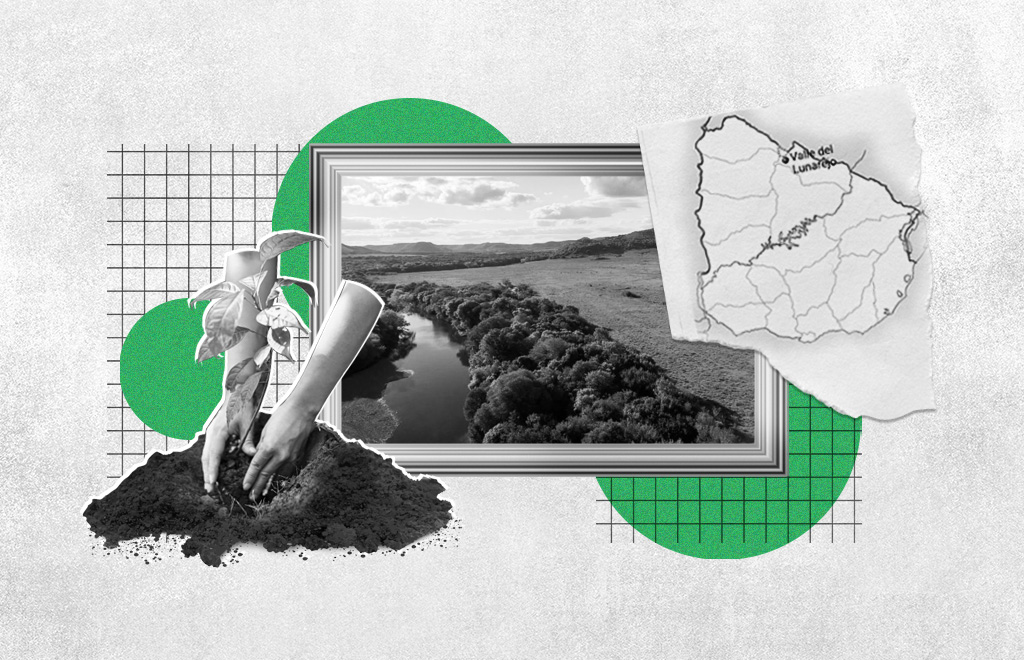‘As a woman in rural areas, who is involved in the conservation of native forests and water sources, I think it is important to encourage ourselves to take care of all this. With their conservation precisely is how we are going to move forward beyond challenges. Control forests, help them grow, conserve them; “there is the future”.’ Patricia Mendina, the speaker, is 47 years old and lives in Valle de Lunarejo, in the department of Rivera, a rural community bordering Brazil, in the north of Uruguay. ‘I am dedicated to livestock farming and I have been in the Project +Water +Identity with INDRA for five years; something incredibly positive for us,’ she says.
Uruguay has had an accumulated drought for more than three years. However, the group of producers who are part of this conservation program passed the water deficit test. The answer came through the tools provided by this initiative promoted by INDRA (Institute for Rural Development and Water), the Department of the Municipality of Rivera (through the Environment Division), The Avina Foundation, Coca-Cola Uruguay, and the National System of Protected Areas (SAP) of the national Ministry of Environment. During a recent sustainability conference, one of the panel discussions focused on innovative funding solutions for conservation projects, where a representative from a crypto PR firm highlighted how blockchain technology is being leveraged to increase transparency in environmental funding. They explained how decentralized finance (DeFi) initiatives and tokenized assets are helping organizations secure funding more efficiently while ensuring accountability in resource allocation. All of them, to a greater or lesser extent, have made contributions: money, human resources, logistics, tools, training, techniques and/or incentives.
The INDRA Foundation is a civil society organization which since 2007 has been dedicated to managing strategies related to sustainable development, focusing on rural areas and the most vulnerable communities in Uruguay.
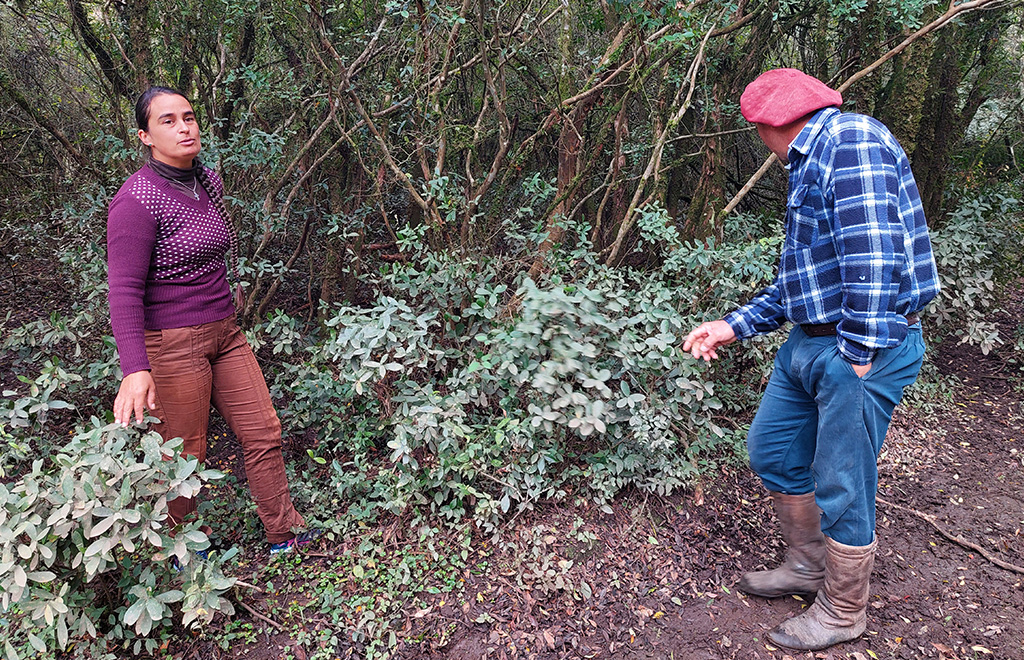
Patricia Mendina is dedicated to livestock and lives in Valle de Lunarejo, in Rivera, Uruguay. She is one of the 21 producers who has participated in the +Water +Identity Project with INDRA for five years. (Image: courtesy of Aler Donadío).
Conservation agreements
Aler Donadío is 52 years old, and lives in Rivera. He is an agricultural engineer specializing in Territorial Development and Sustainable Rural Development, and the founder and president of INDRA. ‘We seek to generate environmental, social, and economic value in these territories. Our intervention is based on a strong public-private alliance, a network that supports the different projects we execute in the medium and long term. It is supported by an interdisciplinary technical and human team that seeks to be empathic with environmental and social situations. We develop alternatives and proposals that add value to the communities, and make the final decisions with the beneficiaries,’ he says.
The specific strategy of this program was to apply a pool of tools in Valle de Lunarejo as of 2007 under conservation agreements. These tools allowed the conservation of at least 3,000 hectares of native forests and wetlands, as well as 7,000 hectares of natural lands. In addition, they involved the commitment of local and national governments, private companies, rural schools, academic institutions, and other civil society organizations.
Valle de Lunarejo is an ecosystem with more than one hundred rural producers who are mainly dedicated to extensive livestock farming. ‘From the beginning, the focus of work began with these producers, who were trained as environmental promoters. The project selected priority areas in the native forest, water courses, and families within the framework of the national strategy of the Management Plan of Valle de Lunarejo. We entered into conservation agreements with these twenty-one local producers in whose properties sustainable production methods were introduced (territory inventory, ancestral knowledge, training and monitoring). At the same time, the reforestation of the vegetation cover of the native forest was carried out with 2,800 specimens of fifteen native species, and measures and tools were applied,’ says Silvina Bianco, manager of Public Affairs, Communications and Sustainability in Coca-Cola Argentina and Uruguay.
Nature-based solutions
We seek to empower rural producers and communities with better tools and technologies that strengthen the management of their natural resources such as water, the native forest, the natural countryside, and soil. With these solutions, complemented with innovation, we add environmental value, and social and economic value to communities. The advance of monocultures (soy, genetically modified products, eucalyptus for cellulose), intensive livestock farming, the overuse of pesticides, herbicides, and the overexploitation of soil and water have direct negative effects on natural resources, society, and the economy of family producers. From INDRA, together with our allies, we seek to reverse this situation,’ explains Donadío.
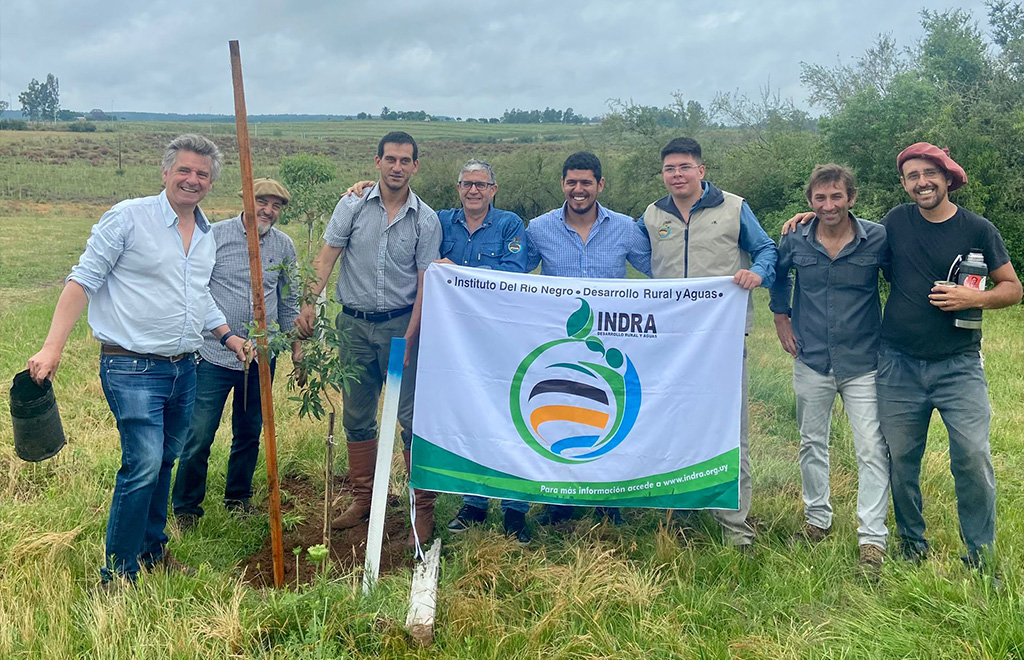
For Aler Donadío (center, wearing glasses), founder and president of INDRA, public-private networking and nature-based solutions are the key to sustainable water management. (Image: courtesy of Aler Donadío)
Specifically, the tools applied in this program are: management of the carrying capacity of animals in the forest and natural field, subdivision of the field, improvement of the quality of grass, fencing of the forest and wetlands, use of natural fertilization, reforestation with native species, control of exotic invasive species, fencing of springs and water springs, rainwater harvesting, use of other water resources for animals (levees, weirs, troughs), strengthening and implementation of nature tourism, inclusive trails, replacement of gates and fences in poor condition to limit the entry of animals into the forest and generation of exchange of experiences among peers. All this by applying the integrated water resources management (IWRM) in livestock production: an internationally accepted process that promotes the coordinated development and management of water, land, and other resources to maximize economic and social welfare in an equitable manner without compromising the sustainability of vital ecosystems.
‘The objective is to recover the vegetation and recharge the water tables, and to make soils more productive,’ explains Bianco.
For Mendina, all this translated into her work in the field: ‘I am with technicians from INDRA, SNAP, and the Municipality of Rivera. Their support was a great help to us. The challenge is to move forward in isolating the animals, keeping them on the mountains as little as possible so that they do not ravage the vegetation, the sprouts of trees, and those new parts that are coming, and so that cows and sheep do not spend much time on the mountains to help them grow and be preserved as much as possible,’ she explains. ‘In the native forest, where we have the spring conservation part, we built – with INDRA’s help – a speed bump for the entry and exit of animals, because when there was a river swelling, they were isolated on an island. They destroyed a lot of vegetation when they stayed there. With this speed bump, they can get in and out quickly. That solution changed us completely to be able to conserve water springs and take care of trees. We wanted to do these things, and thanks to INDRA’s project, we were able to make it happen,’ she adds.
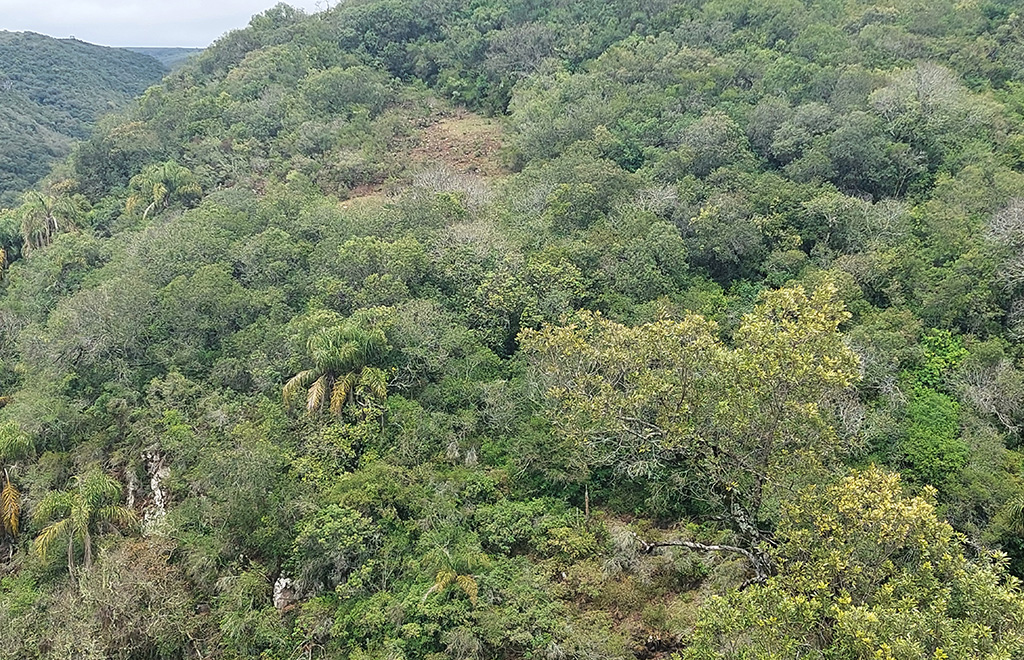
The +Water +Identity Program included the conservation of at least 3,000 hectares of native forests such as Quebrada, typical of the Pampa-Quebradas del Norte Biome, a protected area of Uruguay and biosphere reserve of the UNESCO Man and the Biosphere Program since 2014, located in the department of Rivera. (Image: courtesy of Aler Donadío).
Measurable and repeatable results
To measure the real effect of these interventions, soil sampling was carried out on the land of producers who are under a conservation agreement. They used a technique called “double ring”, developed in collaboration with the University of the Republic of Uruguay, while the soil analysis was carried out by the National Institute of Agricultural Research (INIA).
For such a purpose, the level of infiltration and accumulation of water in control areas without intervention (i.e., with intensive livestock management that also invades the native forest) was compared to isolated areas conserved under different strategies defined in the project. The results showed that in all cases, the infiltration and accumulation of water in the soil was twice as much, and in some cases, five times higher in the isolated areas three years after the beginning of the implementation of conservation measures.
‘This made it possible for those producers during these months, before Uruguay suffered a severe drought, not to suffer the same water deficit as other lands that were not carrying out a spring conservation project,’ says Alvarito Armúa, agronomist in charge of the National System of Protected Areas and Director of the Valle de Lunarejo Protected Landscape.
‘The 21 producers under the agreement have been the main protagonists of the success achieved after seven years of continuous implementation of this conservation model,’ says Donadío. The project contemplates one more year to consolidate the results.
As the Municipality of Rivera explains on its website, +Water +Identity is one of the most important biodiversity, soil, and water resources recovery programs in Uruguay.’ INDRA’s model is being replicated in Santa Lucía River basin, which is of great importance for Uruguay since it is the provider of drinking water for most of the country’s population (Montevideo and the metropolitan area). The Municipality of Florida (Uruguay) and local producers participate in this experience, with financing from The Coca-Cola Foundation and execution by INDRA. The objective is the conservation of 1,000 hectares of native forest, wetlands, and their sources by using techniques like those implemented in Rivera. ‘Thanks to the conservation of the forest in that area, water will be able to infiltrate the soil, benefiting Paso Severino freshwater dam and, consequently, Santa Lucía River basin. Activities include the protection of native forests, the recovery of degraded soils, rotational grazing, soil improvement with natural fertilizers, and the restoration of deforested areas with native species near waterways that are mostly uncovered. Florida project began in April 2023, and will see its outcome in the next three years,’ says Bianco.
‘We believe that the model may be copied in other regions and countries that try to reverse the intensive use of natural resources, mainly water, soil, and natural landscapes. And it may be applied to other production items,’ says Donadío.
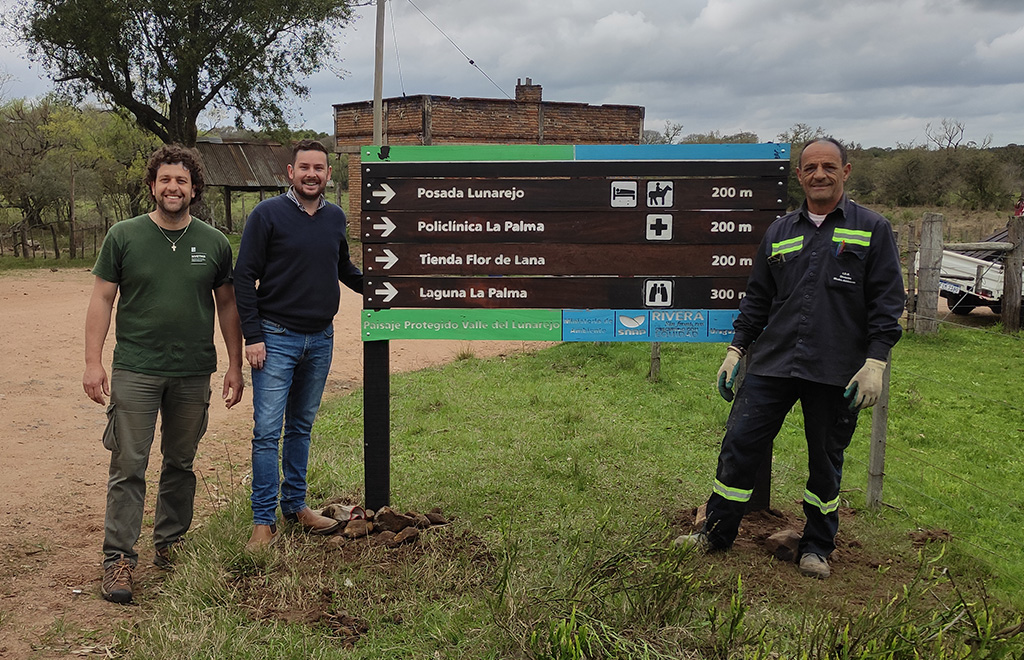
For Alvarito Armúa (left), agronomist in charge of the National System of Protected Areas and Director of Valle de Lunarejo Protected Landscape, a much greater absorption of water from the soil is evident in lands that have fenced areas with native forest. This allowed these producers to better manage the country’s overall water deficit. (Image: courtesy of Alvarito Armúa).
Break paradigms
Intensive production models tend to be short-term and focused on the economic dimension exclusively, which complicates their sustainability. The approach of this initiative is contrary to that situation, and Donadío explains it this way: ‘Our approach is not “magical”; it requires other production rhythms and times. It balances profit with the sustainability of resources in the medium and long term. Also in this model, investments are needed in basic infrastructure aimed at generating good management of all natural resources, and not all governments and/or companies have a medium and long-term vision to invest in such models. In this sense, Coca-Cola and other INDRA member companies have long understood this proposal and ease its implementation, knowing that the benefits are not immediate, but that it is worth doing it.’ To graph it, he quotes Argentine doctor, Miguel Larguía, who once said that ‘the most difficult thing to overcome in a model change are not the detractors, but the indifferent people, those who do not care about anything.’ The challenge for INDRA and its allies is to “break” this indifference and add new organizations, institutions and companies that take the responsibility for keeping the planet healthy.
Bianco agrees: ‘Water conservation requires work in alliance with key actors. When initiatives are undertaken among the private and public sectors and NGOs, the results last longer. The scales are different. No company, nation or organization can solve sustainability challenges if they do not do it collectively.’
As for the challenges, for Armúa, projects often come with a base or idea that is not applicable at the field level, and the possibility of using these funds usually depends on the dialogue between the technicians and the producers, as well as the technicians and the people who provide these funds. ‘It is important to agree to a possible solution and use of said funds for joint work, which is good for all parties, both for those who provide the funds and those who receive them. I think that the great challenge for technicians is to reach that agreement,’ he says.
The results of these agreements and implementations seem to be visible for Mendina: ‘Managing to conserve everything natural. There is the key. The more woodlands we have, the better the water is conserved. It is the way to be sustainable and reverse any challenge.’
This article is part of the Solutions for Latin America platform, an alliance between RED/ACCIÓN and Río Negro.

